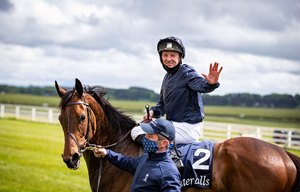Jockey Weight Requirements in Ireland See Change


Leading jockeys Seamie Heffernan and Robbie Power have given a thumbs-up to new increased minimum riding weights in Ireland, introduced to aid the wellbeing of riders.
The lowest weight for jockeys on the flat will be increased by 3 lb to 119 lb, while over jumps the minimum weight will now be raised 4 lb to 140 lb, taking effect from Feb. 1 after an HRI board meeting Dec. 17.
A 2lb weight increase, introduced last year when racing returned from a COVID-enforced shutdown without any sauna facilities, will be retained on a permanent basis under both codes.
This means a standard topweight in flat handicaps of 142lb and in jumps handicaps of 1628lb.
There will be adjustments to some weight structures in jump races where the lowest riding weights would still be high, including beginners' chases and maiden hurdles at 166lb rather than 168lb. Similarly, bumpers will see horses carry 168lb as opposed to 170lb.
Heffernan, one of the flat weighing-room's most successful and senior figures, told the Racing Post: "When I got into racing at first you could easily see that jockeys were generally very small. That has changed.
"Most riders coming through now are tall and lean. With that in mind, I think this move is definitely a help. There have been lots of studies done on the topic and people just seem to be getting taller. I think this has to be a positive."
Cheltenham Gold Cup and Grand National-winning rider Robbie Power believes the weight rise will come as a positive to some, but suggested that it may not necessarily be a benefit to all riders, particularly those capable of making the lowest weights.
Power said: "For the majority of lads in the weighing room this probably won't change a whole lot. It is a positive step, but there will also be jockeys able to do 136lb and 138lb who it could disadvantage. It will work both ways.
"It was probably only a matter of time that this happened. The lowest weight in Britain has been 140lb and at least we're going to be on a par now."

He added: "Lots of sauna use can't be good for riders' heads, and the less you sweat, the more stable your weight becomes. I'd imagine it was hard for some to change and they'll have had to work hard on their diet to manage a more stable weight. Having no saunas on a racecourse has to be a good thing for a lot of reasons."
IHRB senior medical officer Dr. Jennifer Pugh presented concerns to a cross-industry Jockeys Supports Working Group on the increasing stature of the current jockey population and their weight-making practices.
Major physical health effects of making weight, as well as pronounced mental health effects, were raised by the SMO, who highlighted that the number of overweights has fallen 84% since the introduction of the 2lb allowance.
Pugh said: "I very much welcome these changes to the weight structures which are crucial as we continue to improve the physical and mental health of our jockeys.

"I look forward to close collaboration with HRI through its equuip division and our other supportive industry partners as we continue to improve our educational and wellbeing supports to ensure healthy weight-making practices become the norm."
She added: "I wish to thank HRI and the Jockey Supports Working Group for their time and support in recent months in achieving these changes."
HRI has also committed to examine ways in which non-race day supports can be expanded through the Jockeys Pathway program, attempting to further educate riders and provide the supports required to make weight using healthier methods.
In Britain, the minimum weight is 112lb on the flat and 140lb over jumps, but riders get an additional 3lb allowance for body protectors and since COVID they have had another 3lb on top of that due to lack of saunas. So a horse listed carrying 126lb actually carries 132lb.
